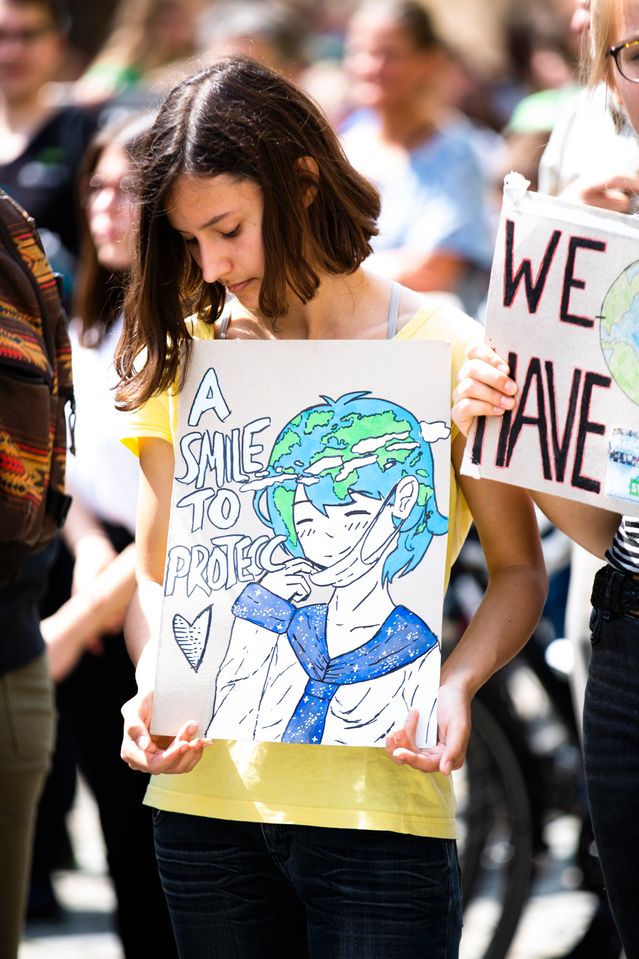Anxiety
Will the Kids Be All Right?
Gen Z is both highly anxious and highly capable.
Posted January 23, 2020 Reviewed by Matt Huston

When I first started psychiatrically assessing and treating high school and university-age youth in 1996 and asked my patients if they suffered from anxiety, it was not uncommon for one of them to ask me, “What’s anxiety?” “Excessive nervousness or worrying,” I would have to explain.
I have since done in-depth assessments on thousands of kids this age and provided long-term care to many hundreds of them, some of them for many years (indeed, a few of my first patients are still seeing me in their late 30s and early 40s).
I’m also a parent of three kids who are now in their late teens and young adult years.
Anxiety has always been a common affliction, though in the past a lot of anxious people did not realize they were anxious. Even today, among older generations, this is often the case. Particularly since anxiety manifests in some people more as irritability or as an 'uptight' manner rather than as obvious nervousness or worrying.
Is Gen Z more anxious than generations past?
It seems that among today’s young people, more than half of them self-label as suffering from anxiety.1 The experience of anxiety is familiar to us all. Anxiety is on a continuum in the general population in terms of the degree to which individuals are prone to it. Anxiety disorders are just one end of that spectrum and are defined by degree of distress and impairment of functioning. The line separating abnormal from normal anxiety is fuzzy.
Anxiety disorders are among the most common psychiatric conditions. To determine the prevalence of 'true' disorders in the general adolescent population, the National Comorbidity Survey carefully applied DSM-IV criteria in face-to-face interviews with over 10,000 U.S. teens in 2001-2004 and found that 31.9% met criteria for an anxiety disorder by the age of 18. But this included 19.3% with a specific phobia, which for most sufferers is not usually a very disabling problem. Only 8.3% of all adolescents had suffered severe impairment of functioning from an anxiety disorder.2
Many people afflicted with anxiety also become depressed, to varying degrees of severity. But many who are anxious erroneously assume they are depressed, with the experience of feeling overwhelmed by stress, the tearful emotionality, and anxious avoidance all easily mistaken for depression.
The apparently increased rates of anxiety and depression in youth have been blamed on smartphones and social media,3 but more careful studies haven't born this out.4 There is a correlation between extreme use of social media and poor emotional wellbeing in young people, but the direction of causality is unclear—more anxious and depressed youths may be more likely to become heavy social media users.
There is little evidence that the incidence and prevalence of serious mental illnesses have increased in youth, or for that matter in adults.5 What appears to be the case is an increased rate of consultations for mild to moderate anxiety and depression.6
So what’s with all the self-labeling? Young people have been very receptive to the increased efforts made since the 1990s toward education about and destigmatization of mental illness. This generation has really bought into the language of mental health and the advice to talk openly about it. Some of this represents wonderful progress, resulting in increased detection and intervention for serious mental health problems, and preventing milder problems from escalating. But today’s youth seem almost to have replaced the use of the word "stress" with "anxiety disorder" or "mental health problem." In some ways, this is just an extension of a much longer trend toward increasing recognition of psychological distress and increasing psychological-mindedness in modern times.
Getting to know Gen Z
Gen Z (also called iGen), the generation following the Millennials, is generally thought of as the generation born between 1995 or 1997 and 2010 or 2012, though cut-offs vary. While there are good reasons to be skeptical about generalizations and categorizations of generations, it is reasonable to assume that there may on average be non-trivial factors differentially affecting the upbringing of these kids who were born as native internet users in a world bombarded with information and news, and who as teens had smartphones in their pockets and near-constant access to social media. Just as importantly, many in this generation grew up in the aftermath of 9/11, in the era of the War on Terror and in the years following the Great Recession. And in the last several years, many have been exposed to talk of climate catastrophe and the increasingly virulent polarization between the political left and right. [Postscript: this article was written shortly before the beginning of the COVID-19 pandemic, which undoubtedly will have a powerful impact in defining this generation].
Gen Z does contrast with (at least the older of) the Millennials, who, in Western countries, were mostly raised during the economic prosperity and relative peace of the 1990s, until the sheltered, optimistic view many of them had was shaken by world events in their teens or young adulthood.
Gen Z is acutely aware that they are entering a highly competitive job market, with a high cost of living—particularly housing and (especially in the U.S.) student debt, which means that many of them will take much longer than their parents did to launch themselves into financial independence. Added to this, they are also very aware that they will require a lot of higher education. Close to a majority of young adults in Western countries (and in some countries such as Canada, well over a majority) now need and obtain post-secondary education. Gen Z is on track to be the best-educated generation yet.7 I don't hear many kids these days saying "we don't need no education." Adding to the educational and career pressures of teens and young adults is the sheer number and complexity of career path choices available to them. In a sense, life used to be simpler.
By many accounts, compared with previous generations at the same age and stage, this generation is more informed and aware of the world around them—no doubt due to the ubiquitous internet and its information tsunami. They are also savvier about critically appraising that information and not just believing everything they read.8 It is actually possible that they may be smarter, possibly in part owing to the saturation of their world with abstract symbolism.9
They are also more comfortable with and tolerant of diversity of all kinds, due to the more diverse society in which they are immersed. And they are much less religious—which, depending on your own level of secularism/religiosity, you will probably regard as either a good thing or a bad thing.10
They expect to work harder than previous generations11 and are more pragmatic and risk-averse with their finances.12 Early indications from marketing surveys suggest they may be less materialistic, too.13
They are more safety conscious and engage in less risky youthful behaviour14, with lower rates of violence,15 less alcohol use and less drug use other than cannabis (which has increased somewhat—Gen Zers perceive cannabis to be low risk, but their usage has not increased as much as most people assume16). They drink and drive less17 (however, they text and drive more). They even eat healthier (though, of concern, in some countries they may be getting less exercise, leading more sedentary lifestyles).18
High school-age Gen Z kids are more likely to talk to their parents about important personal issues.19 They have sex later and have very low rates of teenage pregnancy relative to previous generations. They are on track to continue the trend of the last half-century toward later marriage (probably a good thing), later childbirth (probably a good thing, on balance—they will be more prepared parents). And young women are entering high-end professions in unprecedented numbers, in many cases overtaking young men.20
Gen Z is more politically engaged, and also more engaged in the community, volunteering more than previous generations.21 They are more environmentally conscious and are especially worried about climate change.
Certainly, they will need to learn to tolerate anxiety and uncertainty more effectively and to become more self-reliant, but I don’t think they are on average less resilient or less resourceful. As the psychologist Jean Twenge has put it, they are simply taking longer to reach full adulthood, which, considering their long education and obstacles to financial independence, is understandable and in many ways could be a good thing.
As for the over-reach of this generation’s campus politics, which has been much criticized and ridiculed—demands for trigger warnings for (sometimes) relatively minor upsetting content, safe spaces, and cancel culture—and which has led to concerns about stifling free speech and higher education,22 this is likely to mellow with maturity and life experience the same way that the radical extremes of previous generations did. (And, just as some of it has undoubtedly been overdone, so too has some of the criticism of it been overstated and straw-manned.23)
Moral progress and hope for humanity
Gen Z seems to be continuing a well-documented trend of civilizational moral progress, a centuries-long trend that has accelerated in the last few decades. Yes, there have been and will continue to be many setbacks and temporary regressions—some of them colossal and providing plenty of cause for despair about human nature. And yet even those are still ultimately eclipsed by the overall global improvement in human quality of life. Human progress has been a case of two steps forward, one step back. There is still far too much injustice and human cruelty in today’s world, but the world is, in fact, a very much less violent, less oppressive, more cooperative and more compassionate place than it was at practically any other time in human history.24
Working on such an intensely personal level with so many members of this generation, despite all their anxiety, inspires me with confidence that the future is in more capable hands than ever before.
References
1. For example, 63% of 18 to 29-year-old Canadians surveyed in 2017 considered themselves someone who struggles with anxiety, and even higher numbers (71%) among females in this age group.
2. Merikangas KR, He JP, Burstein M, et al. Lifetime prevalence of mental disorders in U.S. adolescents: results from the National Comorbidity Survey Replication--Adolescent Supplement (NCS-A). J Am Acad Child Adolesc Psychiatry. 2010; 49(10):980–989. doi:10.1016/j.jaac.2010.05.017.
3. See "Have Smartphones Destroyed a Generation?" and "iGen."
4. Orben, A., and A. K. Przybylski. "The association between adolescent well-being and digital technology use." Nat Hum Behav 3, no. 2 (Feb 2019): 173-182; Heffer, T., Good, M., Daly, O., et al. "The Longitudinal Association Between Social-Media Use and Depressive Symptoms Among Adolescents and Young Adults: An Empirical Reply to Twenge et al. (2018)." Clinical Psychological Science 7, no. 3, (2019). And here.
5. Serious mental illness generally refers to illnesses such as schizophrenia and bipolar disorder. Even for anxiety disorders, the rates of strictly defined disorders do not seem to have changed much—what has increased is symptoms rather than the full-blown disorder. E.g. see John, A., A. L. Marchant, J. I. McGregor, J. O., et al. "Recent trends in the incidence of anxiety and prescription of anxiolytics and hypnotics in children and young people: An e-cohort study." J Affect Disord 183 (Sep 1 2015): 134-41. And Bandelow B, Michaelis S. Epidemiology of anxiety disorders in the 21st century. Dialogues Clin Neurosci. 2015;17(3):327–335. And this infographic. But some studies have found an increase in the prevalence of diagnoses, e.g. Lipson, S. K., E. G. Lattie, and D. Eisenberg. "Increased Rates of Mental Health Service Utilization by U.S. College Students: 10-Year Population-Level Trends (2007-2017)." Psychiatr Serv 70, no. 1 (Jan 1 2019): 60-63. The authors relate the increased service utilization and diagnoses in part to decreased stigma. Also of concern, there has been an uptick in the suicide rate among youth, especially girls, in the United States in 2007-2015, after it declined to its lowest point in 2007 (the 2015 rate for boys was still lower compared with its peak in the mid-1990s, as the decline in suicides for boys had been steeper). Suicide rates in most other countries have actually continued to fall. For now the U.S. appears to be an outlier. While not all suicides are due to mental illness per se, we can all agree that whatever is causing these young people to take their lives, it is a very serious societal concern.
6. Some of the apparent increase in rates of mild to moderate mental health problems is also due to my profession making these diagnoses more frequently, which some see as a good thing (increased detection and intervention) and others see as pathologizing of the normal ‘human condition.’ People have always struggled with stress, anxiety, unhappiness, and been impaired in their functioning at times of their lives by what today would be considered various kinds of mental health issues, short of being obviously mentally ill. Countering the argument about labeling 'normal' problems as mental health concerns, some would say that the recognition and treatment of those problems of the human condition represents societal progress (assuming of course that those conditions can be successfully treated or even significantly ameliorated, which is a whole other topic; the short answer is that treatment success is highly variable and depends on a great many factors; the modern societal expectation that all problems are solvable certainly needs a lot of adjustment to align it with reality).
7. https://www.pewsocialtrends.org/2018/11/15/early-benchmarks-show-post-millennials-on-track-to-be-most-diverse-best-educated-generation-yet/; https://ourworldindata.org/tertiary-education#enrollment-in-tertiary-education; http://worldpopulationreview.com/countries/most-educated-countries/; https://www.economist.com/international/2018/01/10/teenagers-are-better-behaved-and-less-hedonistic-nowadays
8. Ipsos MORI, “Beyond Binary: The Lives and Choices of Generation Z”, July 2018. https://www.ipsos.com/sites/default/files/2018-08/ipsos_-_beyond_binary_-_the_lives_and_choices_of_gen_z.pdf
10. Two perspectives: https://psmag.com/ideas/gen-z-is-the-least-religious-generation-heres-why-that-could-be-a-good-thing versus https://www.barna.com/research/atheism-doubles-among-generation-z/
13. Ipsos MORI, “Beyond Binary.”
15. Salas-Wright, C. P., PhD, Nelson, E. J., PhD, Vaughn, M. G., PhD, et al. Trends in Fighting and Violence Among Adolescents in the United States: Evidence From the National Survey on Drug Use and Health, 2002–2014. American Journal of Public Health, April 2017 DOI: 10.2105/AJPH.2017.303743
18. Ipsos MORI, “Beyond Binary.”
19. Ipsos MORI, “Beyond Binary.”
20. https://www.theglobeandmail.com/report-on-business/careers/career-advice/life-at-work/women-entering-the-professions-in-unprecedented-numbers/article32473175/; https://www.aamc.org/news-insights/press-releases/more-women-men-enrolled-us-medical-schools-2017; https://www.nytimes.com/2016/12/16/business/dealbook/women-majority-of-us-law-students-first-time.html
21. Ipsos MORI, “Beyond Binary.”
22. https://www.theatlantic.com/magazine/archive/2015/09/the-coddling-of-the-american-mind/399356/; https://www.amazon.com/Coddling-American-Mind-Intentions-Generation/dp/0735224897/ref=tmm_hrd_swatch_0?_encoding=UTF8&qid=&sr=
24. Or, for the pessimists and cynics, look at it this way: it was even worse in the past. For mountains of rigorously researched data supporting the optimistic view, see for example Steven Pinker, The Better Angels of Our Nature: Why Violence Has Declined (New York: Viking, 2011); and Enlightenment Now: The Case for Reason, Science, Humanism, and Progress (New York: Viking, 2018). See also Michael Shermer, The Moral Arc: How Science and Reason Lead Humanity Toward Truth, Justice, and Freedom (New York: Henry Holt, 2015). And Hans Rosling, Factfulness: Ten Reasons We're Wrong About the World--and Why Things Are Better Than You Think (New York: Flatiron Books, 2018). And for a visual depiction of how the world is getting much better, see Max Roser, “The short history of global living conditions and why it matters that we know it” (Our World in Data, 2018): https://ourworldindata.org/a-history-of-global-living-conditions-in-5-charts/. Or https://www.vox.com/2014/11/24/7272929/global-poverty-health-crime-literacy-good-news




